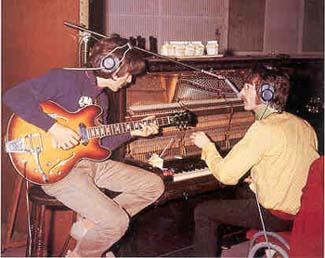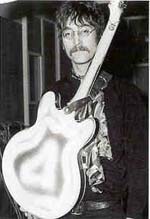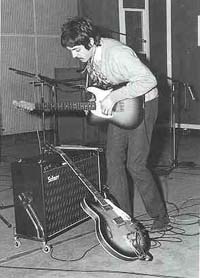|
Just when
you think there could not possibly be another book
saying anything new about the Beatles comes Beatles
Gear (Backbeat Books, 2001). This book details exactly
which guitars, drums, amplifiers and keyboards the Beatles
used at the key points of their relatively brief but entirely
revolutionary career—from the formation of the Quarry
Men skiffle group in the 1960s to the dissolution of the
Beatles in 1970. It provides a fascinating fresh insight
into Beatle history from an entirely new viewpoint, and
along the way many myths are exploded and dozens of stories
told for the first time. John, Paul, George and Ringo’s
moves from cheap early instruments to the pick of 1960s
technology is carefully and entertainingly documented
in an easy-to-read narrative, fully illustrated with many
unseen photographs, a cache of rare memorabilia and a
unique collection of specially-photographed actual Beatle
instruments.
Andy Babiuk, who has worked
at the House of Guitars for more than 20 years, perceived
the need for a book about the Beatles’ gear when
he tried to emulate some of their recorded sounds for
his own band. He then embarked on six years of research,
during which he interviewed over 400 people who worked
with or were closely associated with the Beatles, listened
to hundreds of recordings, watched miles of film and amassed
a vast library of documents and photographic evidence
of the Beatles using their instruments and equipment.
Beatles Gear is perfect for the fan absorbed by
music, rather than hairstyles, for the tribute-band member
with an eye for detail and for any reader with an abiding
interest in the 1960s. It gets right inside the music
and how it all began, such as this excerpt describing
how John Lennon got his first guitar:
 |
Lennon was a restless 16-year-old
when skiffle hit, and along with his schoolmate Pete Shotton
they started their own group. At first they were called
The Black Jacks, but soon became The Quarry Men –
as at first all the members went to Quarry Bank Grammar.
The group started to play at parties and church dances.
The first line-up consisted of Lennon on guitar, Shotton
on washboard, Eric Griffiths on guitar, Rod Davis on banjo,
Colin Hanton on drums, and Bill Smith on the tea-chest
bass. Smith was later replaced by Ivan Vaughan, then Nigel
Whalley, and finally Len Garry.
John Lennon, African
guitar player
The band’s equipment
was primitive, but that was one of skiffle’s requirements.
Lennon’s guitar was a Gallotone Champion, which he
ordered from a newspaper ad. There is a much-repeated
story that Aunt Mimi bought Lennon his first guitar for
£17, but that is not true. Mimi did later buy Lennon a
guitar that involved her parting with £17, but it was
not his first.
 |
Lennon’s biographer
Ray Coleman described how Lennon first tried to coax his
aunt and then his mother into buying him a guitar. Mimi
wouldn’t because she thought it would affect his
studies. Undeterred, Lennon ordered a guitar and had it
sent to Julia’s address, figuring that way he would
run less risk of being scolded by Mimi. This was the Gallotone
Champion. In 1964 Lennon recalled, "I was about 14 when
I got my first guitar. It was a beat-up old Spanish model
which cost about ten quid. It was advertised in Reveille
magazine as ‘guaranteed not to split’." The
Gallotone Champion flat-top acoustic guitar was crudely
constructed, about three-quarter size compared to a regular
model, and made from laminated woods, unlike the solid
material employed for better instruments.
The South African-based
Gallo company had been started when Eric Gallo opened
his Brunswick record shop in Johannesburg in 1926, but
gradually Gallo began to expand as they took on the South
African distribution and manufacturing for big labels
such as Decca and CBS, and in 1946 became Gallo (Africa)
Ltd. Various subsidiary businesses began, and in the late
1930s Gallo set up a small factory next to their Johannesburg
premises to build Singer-brand guitars, banjos, ukuleles
and mandolins. Around 1946 the instrument factory was
moved to a larger, more modern facility in Jacobs, an
industrial suburb of Durban. At about the same time the
company changed the name of its record imprint to Gallotone,
and after a complaint from the Singer sewing machine company
the instrument brandname was also changed. For more than
two decades Gallo built stringed instruments for the South
African market and conducted a large export business.
The operation shut down in about 1969, although Gallo
continues in the music and video business today.
Inevitably, Gallo’s
guitars found their way to Britain, where they were marketed
through a number of outlets to supply the demand for cheap
beginners’ instruments. The Champion was the cheapest
Gallotone; around 1955 it was being offered at a wholesale
price of £2/10/-. This means it probably would have retailed
in the UK for around £6 (about $17 then, and in the region
of £90 or $125 when translated into today’s buying
power). The general sound and playability of the Champion
reflected its low price. Inside the soundhole was a label
that did indeed claim: "GUARANTEED NOT TO SPLIT", and
some versions added: "Specially manufactured to withstand
all climatic conditions." Even, presumably, the heat of
the South African sun. Like many budget guitars of the
day, it was probably torture to play. But none of this
hindered Lennon’s ambition.
"When I was young I
played the guitar like a banjo, with the sixth string
hanging loose," Lennon remembered later. "I always thought
Lonnie and Elvis were great, and all I ever wanted to
do was to vamp," he said, meaning to play simple chords
to accompany songs. "I got some banjo things off OK, [and
later] George and Paul came along and taught me other
things. My first guitar cost me £10, advertised in the
paper. Why did I get it? Oh, the usual kid’s desire
to get up on stage, I suppose. And also my mother said
she could play any stringed instrument. She did teach
me a bit."
Former Quarry Men banjo-player
Rod Davis also disagrees with the story that Mimi bought
Lennon his first guitar for £17. "The very first guitars
that I remember John and Eric Griffiths having were almost
identical, and I don’t think they would have cost
more than £5. Eric’s was a lighter coloured wood,
John’s more of a brownish-red. My recollection is
that John got a mail-order guitar from one of the newspapers.
It had a treble clef on the headstock, between the machine-heads.
The strings weren’t attached to the bridge; they
went over the bridge and to a tailpiece."
 |
Davis points out that a
cheap first guitar was unlikely to cost as much as £17
– which would be the equivalent in today’s money
of about £250, or $350. "That was an awful lot in those
days," he says. "Even a few years later, in 1960, when
I first started work before I went to university, I was
only getting £5 a week, and that was a lot of money. So
£17 would have been a bloody fortune for a guitar." Davis
says that the strings they used were mostly Cathedral-brand
banjo strings and all roundwound, in other words with
round wire wrapped around the central core, as opposed
to flatwound strings which have a flatter, smoother surface.
"Flatwounds were available," he says, "but they were a
lot more expensive – and we were at the bottom of
the market."
He recalls that Lennon
thrashed his Gallotone guitar and frequently broke strings.
"So then he’d take my banjo and play that, and I
would have the job of re-stringing his guitar ready for
the next number. I frequently held that guitar and put
strings on it for him. In fact, he would play it so furiously
that he’d take the skin off his index finger and
spray blood into his guitar. So somewhere somebody’s
got a guitar with brown stains inside, under the soundhole
– which is John’s old guitar."
A Gallotone Champion
was sold for a considerable sum in 1999 by Sotheby’s
as Lennon’s original guitar. The auction catalogue
related that in the 1980s Aunt Mimi had donated this restored
instrument – in a trunk with various other items
– to a Liverpool charity that asked for her articles
owned by Lennon. Among other items with the guitar in
the sale was a typed and undated letter signed "Mimi",
agreeing to the request.
"I must admit I didn’t
know these things still existed until John asked me to
sort out his bits and pieces from the old days and send
them on to [New York]," the letter states. "The poor old
guitar was in such a state when I found it I had it professionally
repaired." The auctioned guitar had indeed been restored,
including a completely new paint finish, and (presumably
done at the same time) a plaque added to the headstock
reading: "Remember You’ll Never Earn Your Living
By It". The sale catalogue says the plaque referred back
"to a remark [Mimi] is reported to have made out of exasperation
with the hours John spent practising rather than studying".
*Andy
Babiuk is a musician and writer and is staff consultant
to the Rock & Roll Hall of Fame.
|